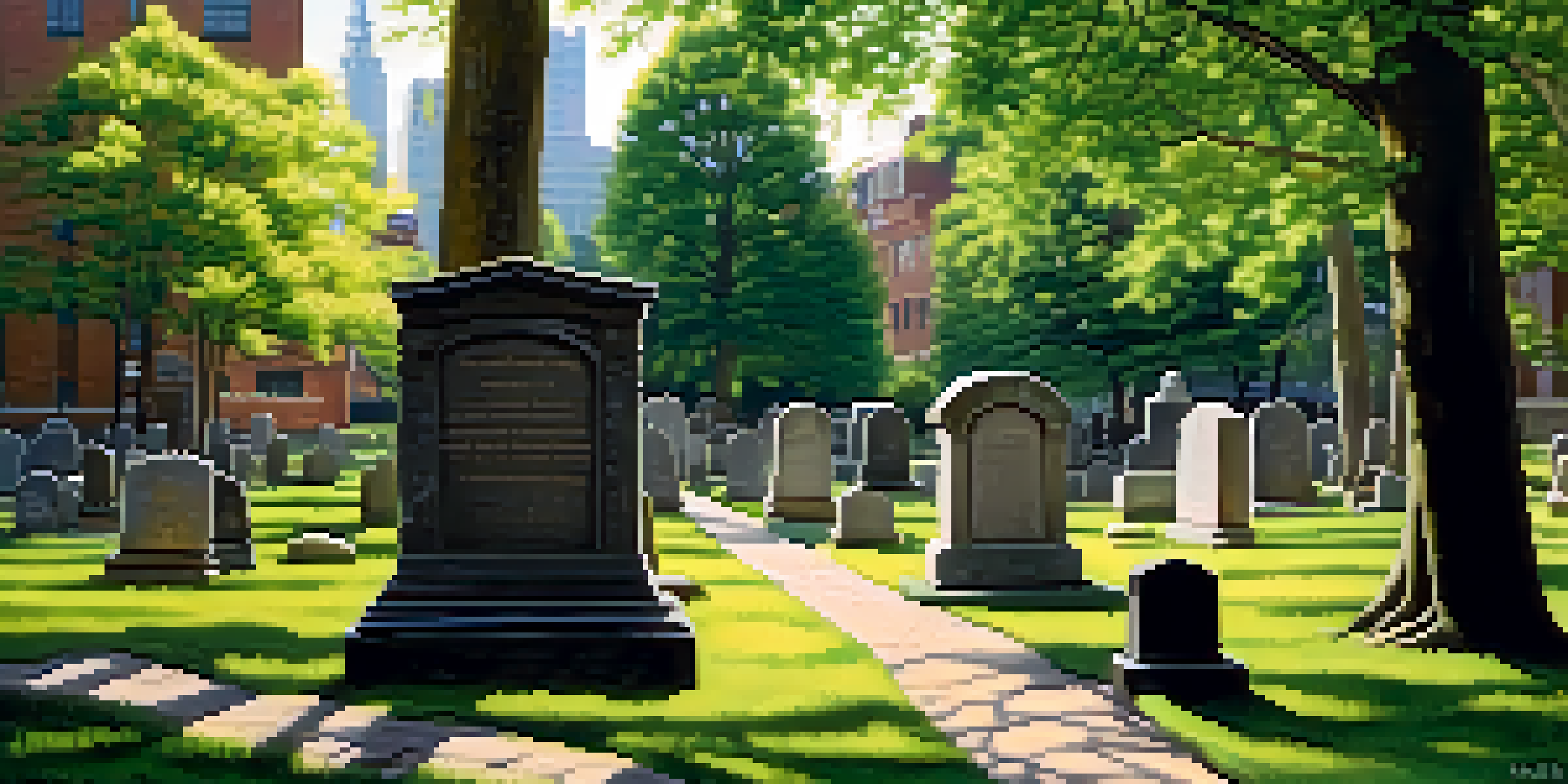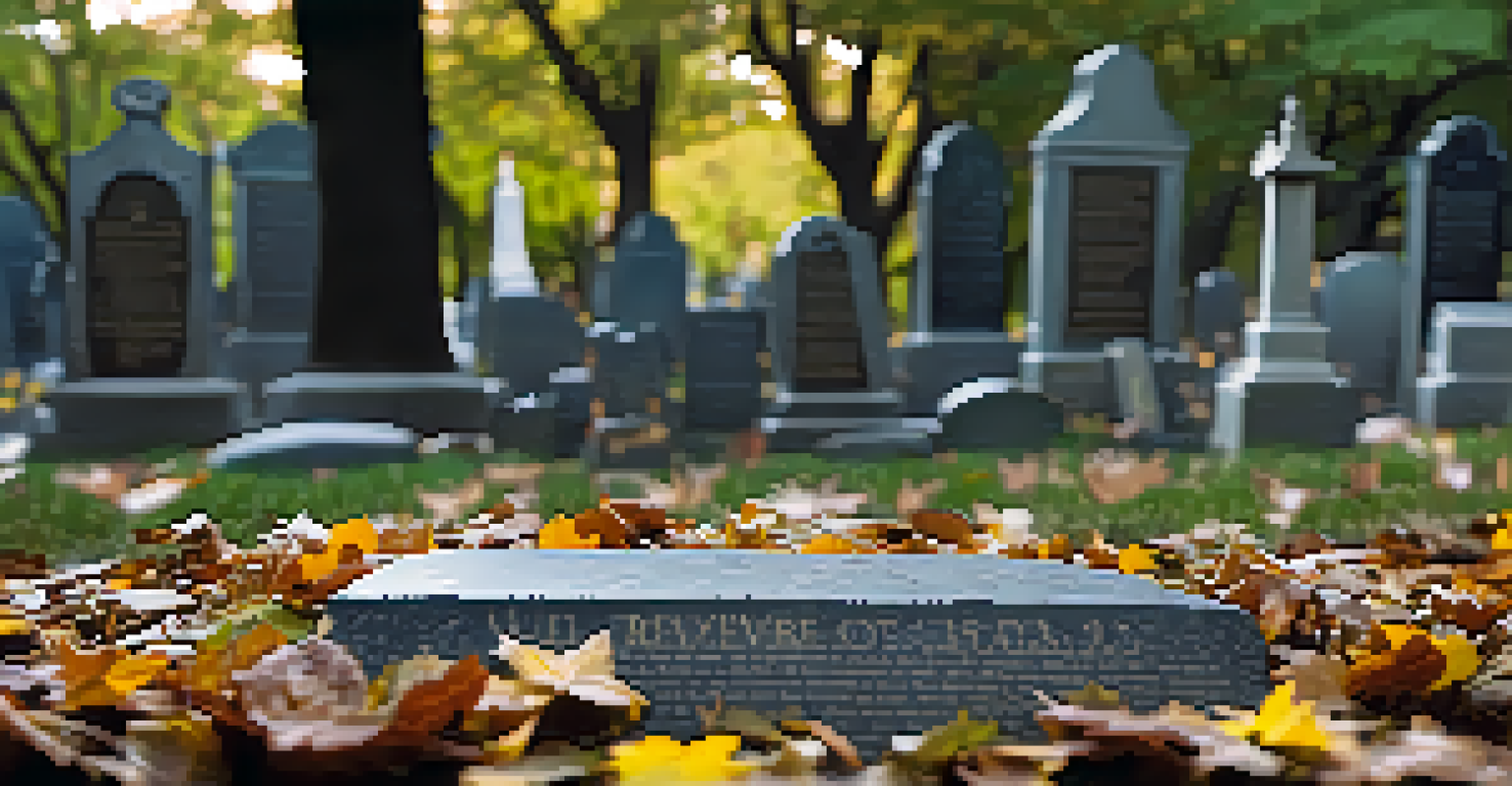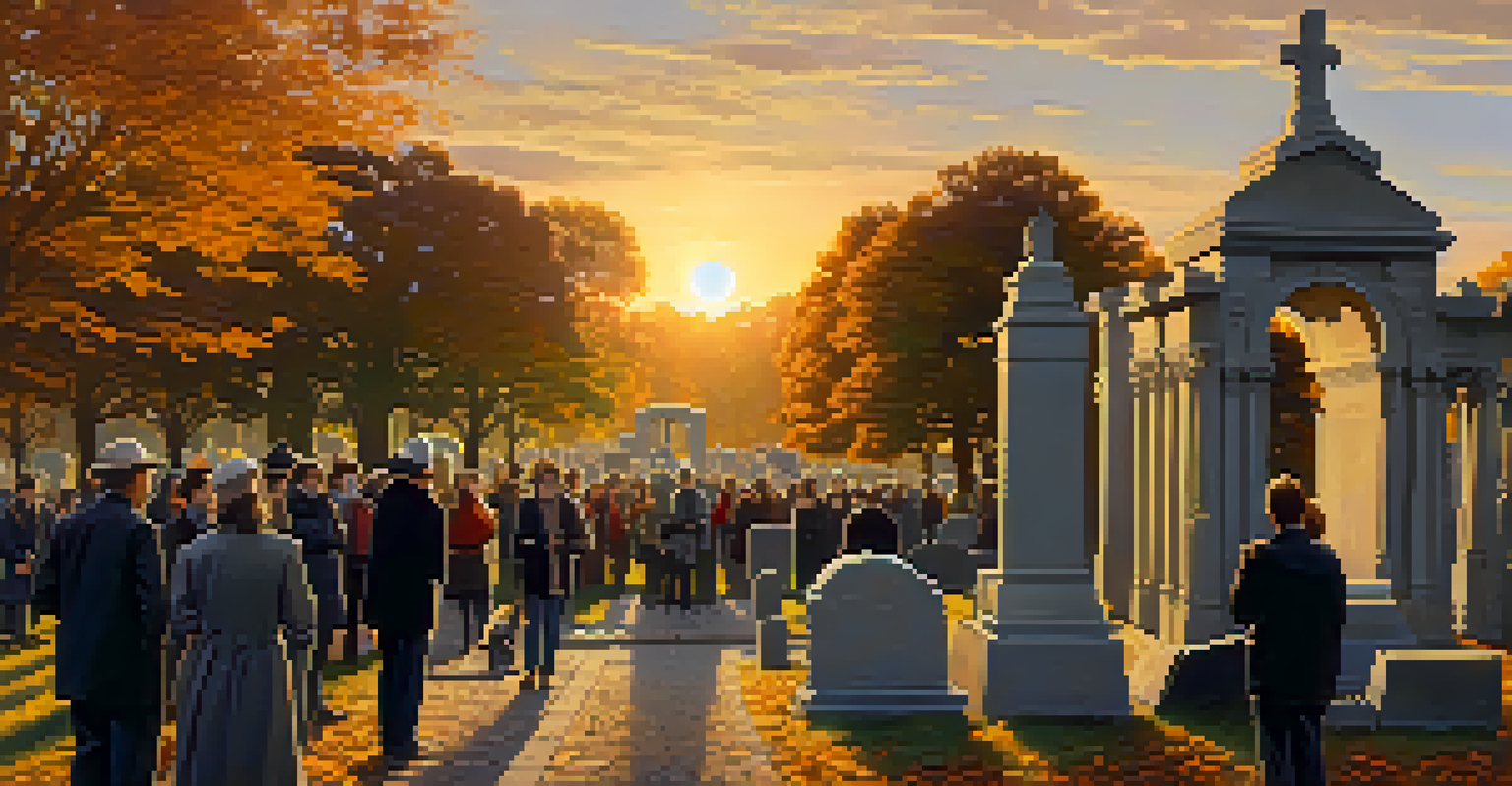Famous Graves: Who Lies Beneath Boston's Historic Cemeteries?

The Historic Significance of Boston's Cemeteries
Boston is home to some of the oldest and most historic cemeteries in the United States. These burial grounds are not just final resting places; they are also snapshots of the city’s rich history. From the colonial era to the revolutionary times, these cemeteries reflect the diverse stories of those who shaped Boston.
History is not a burden on the memory, but an illumination of the soul.
One of the most famous burial sites is the Granary Burying Ground, established in 1660. This cemetery is the final resting place of many notable figures, including Paul Revere and Samuel Adams. Walking through these hallowed grounds, visitors can feel the weight of history and the lives that once thrived in this vibrant city.
As you stroll through these cemeteries, it becomes clear that each grave tells a story. The inscriptions on the headstones often reveal the values and sentiments of the time, making them a fascinating study of both individual lives and the societal context of their eras.
Paul Revere: The Midnight Rider
One of the most iconic figures in American history, Paul Revere is remembered for his midnight ride to warn the colonists of British troops. His grave, located in the Granary Burying Ground, attracts countless visitors who pay their respects to this revolutionary hero. The simple yet poignant headstone reflects his humble beginnings and the significant role he played in America’s fight for independence.

Revere's legacy extends beyond his famous ride; he was also a skilled silversmith and an early industrialist. His contributions to the American Revolution, as well as his craftsmanship, are celebrated across the country. Standing by his grave, you can't help but feel a connection to the passionate spirit of the era he represented.
Boston Cemeteries: Living History
Boston's historic cemeteries serve as living history museums, offering insights into the lives and contributions of those buried there.
Visitors often leave tokens like coins or small notes at his grave as a sign of respect. These offerings symbolize the enduring impact of his actions and how they continue to resonate with people even centuries later.
Samuel Adams: Founding Father and Brewmaster
Another prominent figure resting in the Granary Burying Ground is Samuel Adams, a key leader in the American Revolution. Known for his fiery speeches and relentless activism, Adams played a crucial role in organizing resistance against British rule. His grave serves as a reminder of the fierce dedication he had for American independence.
The dead cannot cry out for justice; it is a duty of the living to do so for them.
Adams was not only a politician but also a brewer, which adds an interesting twist to his legacy. The beer he produced helped to fund revolutionary activities, making him a unique combination of a founding father and a businessman. This duality is often reflected upon by those who visit his grave, pondering how these roles intertwined during the tumultuous times of the 18th century.
Standing by his gravestone, one can appreciate the sacrifices made by men like Adams. His commitment to liberty and justice is still celebrated today, and visitors often leave behind small tokens of appreciation, reinforcing the spirit of his revolutionary zeal.
John Hancock: The Signature of Freedom
John Hancock, known for his flamboyant signature on the Declaration of Independence, is another notable figure interred in Boston. His grave, located in the Granary Burying Ground, reminds visitors of his pivotal role as a statesman and a patriot. Hancock's larger-than-life personality is reflected in the way he is remembered, and his burial site draws admirers from all over.
Beyond his famous signature, Hancock served as the President of the Second Continental Congress and was a prominent merchant. His wealth and influence played a significant role in the revolution, making him a target for British authorities. Visiting his grave allows you to reflect on the risks and sacrifices made by leaders like him who fought for a new nation.
Notable Figures Resting in Boston
Prominent figures like Paul Revere, Samuel Adams, and notable women, including Abigail Adams, are interred in Boston, each leaving a significant legacy.
Many visitors find inspiration in Hancock's story, often recounting how his boldness and leadership helped shape American democracy. It's not uncommon to see people taking pictures or sharing stories about what his legacy means to them, further solidifying his place in American history.
Benjamin Franklin: A Founding Father with a Twist
Though Benjamin Franklin is primarily associated with Philadelphia, his ties to Boston are deeply rooted, as he was born there. While Franklin's grave is not located in Boston, his influence on the city and its citizens is undeniable. His wit, wisdom, and contributions to the founding of the United States resonate throughout the historic cemeteries.
Franklin's innovative spirit and love for education led him to establish many institutions, including the first public library. His legacy continues to inspire future generations, making him a beloved figure in American history. Even without a grave in Boston, the city pays homage to him through various monuments and historical sites.
Many visitors to Boston seek to connect with Franklin’s ideals of knowledge and civic responsibility. His story serves as an inspiration, reminding us of the importance of curiosity and engagement in shaping our communities.
The Notable Women of Boston's Cemeteries
While many famous graves in Boston belong to men, numerous notable women also lie beneath the city’s historic cemeteries. Figures like Anne Hutchinson, a Puritan spiritual leader, and Abigail Adams, the wife of President John Adams, are just a few examples. Their contributions to society, though sometimes overlooked, played crucial roles in shaping American history.
Anne Hutchinson is known for her strong religious convictions and her challenge to the male-dominated Puritan society. Her grave symbolizes the fight for women's rights and religious freedom in early America. Visitors who stop by her burial site often reflect on the importance of her legacy and the barriers she broke down.
Preservation of Historic Cemeteries
Efforts to preserve Boston's cemeteries are vital for maintaining the city's heritage and honoring the legacies of its historical figures.
Similarly, Abigail Adams, a pioneering advocate for women's education and rights, left an indelible mark on the nation. Her letters to her husband, John Adams, filled with insightful observations about the role of women in society, resonate even today. Stopping by her grave serves as a reminder of the often-unseen contributions women have made throughout history.
Cemeteries as Living History Museums
Boston's historic cemeteries serve as living history museums, offering a unique glimpse into the past. Each grave marker tells a story, revealing not just the names of the deceased but also their contributions to society. This aspect makes visiting these cemeteries a fascinating experience for history buffs and casual visitors alike.
Guided tours often provide context and anecdotes that bring the stories of those buried to life. Visitors learn about the social, political, and cultural dynamics of the times, providing a richer understanding of the city's history. For many, these tours spark a deeper interest in the lives of the people who once walked the same streets.

As you wander through these historic grounds, you come to appreciate the intricate tapestry of lives that have come before. The combination of storytelling and history makes these cemeteries not just places of mourning but also sites of reflection and education.
Preserving History: The Future of Boston's Cemeteries
As time passes, the preservation of Boston's historic cemeteries becomes increasingly vital. Weathering elements and urban development pose challenges to these sacred spaces, making efforts to maintain them essential. Local organizations often work tirelessly to restore and protect these burial grounds for future generations to appreciate.
Community engagement plays a significant role in this preservation effort. Volunteer programs and educational initiatives invite locals and visitors to participate in maintaining the cemeteries, fostering a sense of stewardship. By involving the community, these efforts not only help preserve history but also create a deeper connection between people and the heritage of the city.
Looking to the future, it's crucial to recognize the importance of these cemeteries in preserving Boston's identity. By protecting these sites, we honor the legacies of those who have come before us, ensuring that their stories continue to inspire and inform generations to come.